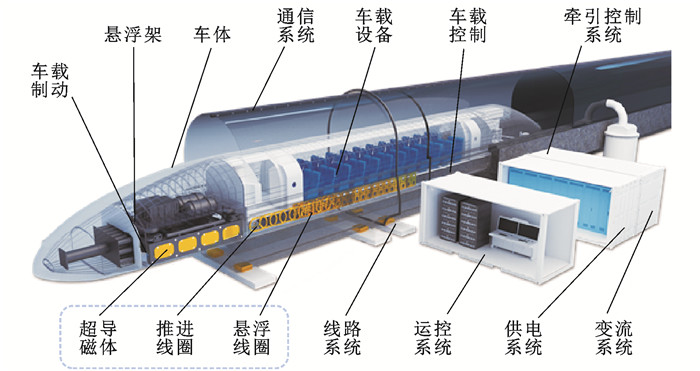-
摘要: 梳理了轮轨列车、电磁悬浮列车、超导钉扎悬浮列车与超导电动悬浮列车台架试验台的研究进展,分析了超导电动悬浮列车推进线圈与悬浮线圈在超导线圈侧产生的空间磁场分布,提出了超导磁体电磁激振试验台的总体方案;介绍了电磁激振试验台核心组成子系统激磁模组和变流系统,提出了变流系统的多频复合电流闭环控制策略;仿真对比了超导磁体在线上运行和电磁激振线下模拟2种工况下的背景空间磁场、电磁载荷与振动加速度响应。研究结果表明:推进线圈和悬浮线圈主要空间谐波磁场阶次分别为2次和5次,对应引起超导线圈产生3倍频和6倍频电磁力波动;通流控制策略可实现二十四相激磁模组直流、3倍频和6倍频电流的控制;电磁激振试验台获取的主要电磁载荷与真实运行情况比较吻合,其中稳态推进力误差不大于3.4%,稳态悬浮力误差不大于8.0%,主要的3倍频与6倍频转矩误差分别不大于6.5%、8.5%;超导磁体各测点加速度响应的线上运行值及线下模拟值趋势与幅值基本吻合。可见,该试验台能够很好地复现实际运行环境下车载超导磁体的背景磁场、电磁载荷与加速度响应,总体方案的有效性得到验证。Abstract: The research progresses of test benches of the wheel-rail train, electromagnetic suspension train, superconducting pinned suspension train, and superconducting electrodynamic suspension train were reviewed. The spatial magnetic field distribution on the superconducting coil side generated by the propulsion coils and levitation coils of the superconducting electrodynamic suspension train was analyzed. The overall solution of the electromagnetic vibration test bench for superconducting magnets was proposed, and the excitation module serving as the subsystem, and the converter system were introduced, which were core components of the electromagnetic vibration test bench. In addition, a multi-frequency composite current closed-loop control strategy for the converter system was proposed. The background spatial magnetic field, electromagnetic load, and vibration acceleration response of superconducting magnets under online operation and offline electromagnetic vibration simulation were simulated and compared. Research results indicate that the main spatial harmonic magnetic field orders of the propulsion coils and levitation coils are the second and the fifth, respectively. Correspondingly, they cause electromagnetic force fluctuations in the third and sixth harmonic frequencies of the superconducting coils. The current control strategy can achieve the control of the 24-phase excitation modules direct current, as well as third and sixth harmonic frequencies currents. The main electromagnetic loads obtained by the electromagnetic vibration test bench are consistent with the actual operating conditions. Specifically, the steady-state propulsion force error is no more than 3.4%, the steady-state levitation force error is no more than 8.0%, and the torque errors of the main third and sixth harmonic frequencies are no more than 6.5% and 8.5%, respectively. The trends and amplitudes of online operation values and offline simulation values of acceleration responses of each observation point of the superconducting magnets are basically consistent. It can be seen that the test bench can well reproduce the background magnetic field, electromagnetic load, and acceleration response of the on-board superconducting magnets in the actual operating environment, and the effectiveness of the overall solution has been verified.
-
表 1 激磁线圈通流相序与极性
Table 1. Phase sequence and polarity of excitation coils
线圈位置 线圈编号 谐波模拟 静力模拟 电动悬浮(6倍频)/(°) 直线同步电机(3倍频)/(°) 悬浮 导向 推进 前层 1/1′ 0/180 0/0 +/- -/- +/+ 2/2′ -60/120 120/120 +/- -/- 3/3′ -120/60 -120/-120 +/- -/- -/- 4/4′ 180/0 0/0 -/+ +/+ -/- 5/5′ 120/-60 120/120 -/+ +/+ 6/6′ 60/-120 -120/-120 -/+ +/+ +/+ 后层 1/1′ 150/-30 60/60 +/- -/- +/+ 2/2′ 90/-90 180/180 +/- -/- 3/3′ 30/-150 -180/-180 +/- -/- -/- 4/4′ -30/150 60/60 -/+ +/+ -/- 5/5′ -90/90 180/180 -/+ +/+ 6/6′ -150/30 -60/-60 -/+ +/+ +/+ 表 2 电磁激振试验台指标
Table 2. Indexes of electromagnetic vibration test bench
指标 数值 基波磁场极距/m 1.5 离线模拟速度/(km·h-1) 0~1 000 电磁间隙/mm 85 悬浮直流载荷模拟能力/kN ≥140 推进直流载荷模拟能力/kN ≥11.5 悬浮6倍频波动模拟频带/Hz 0~560 推进3倍频波动模拟频带/Hz 0~300 持续工作时间/h ≥2 -
[1] 赵鑫, 温泽峰, 王衡禹, 等. 中国轨道交通轮轨滚动接触疲劳研究进展[J]. 交通运输工程学报, 2021, 21(1): 1-35. doi: 10.19818/j.cnki.1671-1637.2021.01.001ZHAO Xin, WEN Ze-feng, WANG Heng-yu, et al. Research progress on wheel/rail rolling contact fatigue of rail transit in China[J]. Journal of Traffic and Transportation Engineering, 2021, 21(1): 1-35. (in Chinese) doi: 10.19818/j.cnki.1671-1637.2021.01.001 [2] 徐飞, 罗世辉, 邓自刚. 磁悬浮轨道交通关键技术及全速度域应用研究[J]. 铁道学报, 2019, 41(3): 41-49.XU Fei, LUO Shi-hui, DENG Zi-gang. Study on key technologies and whole speed range application of maglev rail transport[J]. Journal of the China Railway Society, 2019, 41(3): 41-49. (in Chinese) [3] 马卫华, 罗世辉, 张敏, 等. 中低速磁浮车辆研究综述[J]. 交通运输工程学报, 2021, 21(1): 200-216. doi: 10.19818/j.cnki.1671-1637.2021.01.009MA Wei-hua, LUO Shi-hui, ZHANG Min, et al. Research review on medium and low speed maglev vehicle[J]. Journal of Traffic and Transportation Engineering, 2021, 21(1): 200-216. (in Chinese) doi: 10.19818/j.cnki.1671-1637.2021.01.009 [4] LIU Zhen-dong, SEBASTIAN S, MATS B. Overview of technology and development of maglev and hyperloop systems[R]. Stockholm: KTH Royal Institute of Technology, 2022. [5] 邓自刚, 刘宗鑫, 李海涛, 等. 磁悬浮列车发展现状与展望[J]. 西南交通大学学报, 2022, 57(3): 456-530.DENG Zi-gang, LIU Zong-xin, LI Hai-tao, et al. Development status and prospect of maglev train[J]. Journal of Southwest Jiaotong University, 2022, 57(3): 456-530. (in Chinese) [6] SHI Yan. Research on dynamics of a new high speed maglev vehicle[J]. Vehicle System Dynamics, 2020, DOI: 10.1080/00423114.2020.1838568. [7] 熊嘉阳, 邓自刚. 高速磁悬浮轨道交通研究进展[J]. 交通运输工程学报, 2021, 21(1): 178-198. doi: 10.19818/j.cnki.1671-1637.2021.01.008XIONG Jia-yang, DENG Zi-gang. Research process of high-speed maglev rail transit[J]. Journal of Traffic and Transportation Engineering, 2021, 21(1): 178-198. (in Chinese) doi: 10.19818/j.cnki.1671-1637.2021.01.008 [8] 胡道宇, 冯馨月, 张志华. 超导电动悬浮系统阻尼特性研究[J]. 中国电机工程学报, 2021, 41(13): 4679-4687.HU Dao-yu, FENG Xin-yue, ZHANG Zhi-hua. Study on the damping characteristics of superconducting electrodynamic suspension system[J]. Proceedings of the CSEE, 2021, 41(13): 4679-4687. (in Chinese) [9] JASCHINSKI A, CHOLLET H, IWNICKI S, et al. The application of the roller rigs to railway vehicle dynamics[J]. Vehicle System Dynamics, 1999, 31(5/6): 345-392. [10] 陈良麒, 张卫华, 陈建政. 机车车辆滚动振动试验台和试验方法[J]. 西南交通大学学报, 1997, 32(2): 209-213.CHEN Liang-qi, ZHANG Wei-hua, CHEN Jian-zheng. A roller testing rig of railway vehicles and its testing procedures[J]. Journal of Southwest Jiaotong University, 1997, 32(2): 209-213. (in Chinese) [11] 黄丽湘, 张卫华, 马启文. 机车车辆整车滚动振动试验台设计[J]. 铁道车辆, 2007, 45(1): 5-8.HUANG Li-xiang, ZHANG Wei-hua, MA Qi-wen. Design of rolling and vibration test rig for complete locomotive and rolling stock[J]. Rolling Stock, 2007, 45(1): 5-8. (in Chinese) [12] 沈志云, 张卫华. 中国高铁技术发展中的理论突破和试验突破[J]. 中国发明与专利, 2020, 17(10): 6-16. doi: 10.3969/j.issn.1672-6081.2020.10.001SHEN Zhi-yun, ZHANG Wei-hua. Breakthrough in theory development and in experiment methodology of high-speed rail technology in China[J]. China Invention and Patent, 2020, 17(10): 6-16. (in Chinese) doi: 10.3969/j.issn.1672-6081.2020.10.001 [13] 杨小敏. 轨道车辆转向架悬挂特性试验测量系统研究[D]. 长春: 吉林大学, 2014.YANG Xiao-min. Research on the railway vehicle bogie suspension characteristics testing measurement system[D]. Changchun: Jilin University, 2014. (in Chinese) [14] 张嘉, 邬平波, 刘潮涛, 等. 基于6自由度振动试验台的轨道几何不平顺复现方法及应用研究[J]. 振动与冲击, 2022, 41(8): 46-54.ZHANG Jia, WU Ping-bo, LIU Chao-tao, et al. A track geometric irregularity reproduced method and its application based on 6DOF vibration test bench[J]. Journal of Vibration and Shock, 2022, 41(8): 46-54. (in Chinese) [15] MA Wei-hua, SONG Rong-rong, XU Jun-qi, et al. A coupling vibration test bench and the simulation research of a maglev vehicle[J]. Shock and Vibration, 2015, DOI: 10.1155/2015/586910. [16] 梁鑫. 磁浮列车车轨耦合振动分析及试验研究[D]. 成都: 西南交通大学, 2015.LIANG Xin. Study on maglev vehicle/guideway coupled vibration and experiment on test rig for a levitation stock[D]. Chengdu: Southwest Jiaotong University, 2015. (in Chinese) [17] ZHOU Dan-feng, WANG Lian-chun, LI Jie, et al. Design of a maglev vibration test platform for the research of maglev vehicle-girder coupled vibration problem[J]. MATEC Web of Conferences, 2017, DOI: 10.1051/matecconf/20179509004. [18] LI Hai-tao, DENG Zi-gang, JIN Li-an, et al. Lateral motion stability of high-temperature superconducting maglev systems derived from a nonlinear guidance force hysteretic model[J]. Superconductor Science and Technology, 2018, DOI: 10.1088/1361-6668/aac860. [19] LI Hai-tao, DENG Zi-gang, KE Zhi-hao, et al. Curve negotiation performance of high-temperature superconducting maglev based on guidance force experiments and dynamic simulations[J]. IEEE Transactions on Applied Superconductivity, 2020, 30(1): 3600311. [20] WANG Li, DENG Zi-gang, LI Yan-xing, et al. Vertical-lateral coupling force relation of the high-temperature superconducting magnetic levitation system[J]. IEEE Transactions on Applied Superconductivity, 2021, 31(1): 3600106. [21] WANG Jia-su, WANG Su-yu, DENG Chang-yan, et al. A high-temperature superconducting maglev dynamic measurement system[J]. IEEE Transactions on Applied Superconductivity, 2008, 18(2): 791-794. doi: 10.1109/TASC.2008.920568 [22] DENG Zi-gang, ZHANG Wei-hua, KOU Long, et al. An ultra-high-speed maglev test rig designed for HTS pinning levitation and electrodynamic levitation[J]. IEEE Transactions on Applied Superconductivity, 2021, 31(8): 3603605. [23] EIJI S. Heating phenomena in the superconducting magnet of a maglev vehicle caused by electromagnetic vibration[J]. Cryogenics, 1997, 37: 363-370. [24] MASAYUKI A, MASAO S. Development of electromagnetic vibration test apparatus for ground coils applied to maglev system[J]. Quarterly Report of Railway Technical Research Institute, 2007, 48(2): 110-114. [25] MASAFUMI O, TOMOHIRO O, KAZUYA I, et al. Vibration characteristics of superconducting magnets for the Yamanashi Maglev Test Line vehicles[J]. Quarterly Report of Railway Technical Research Institute, 2000, 41(2): 79-82. [26] TOSHIAKI M, HITOSHI H, TAKAYUKI K. Magnetic vibration simulator with magnetic levitation for EDS maglev[J]. IEEJ Transactions on Industry Applications, 2003, 123(9): 1050-1056. [27] KATSUTOSHI M, MINORU T, MASAFUMI O. Monitoring and protection method of a REBCO magnet designed for electromagnetic vibration tests[J]. Quarterly Report of Railway Technical Research Institute, 2020, 61(1): 60-65. [28] KATSUTOSHI M, MASAFUMI O, MINORU T. Voltage noise measurement of a REBCO superconducting coil during electromagnetic vibration tests on a ground coil[J]. Quarterly Report of Railway Technical Research Institute, 2021, 62(3): 207-212. [29] HU Dao-yu, ZHANG Yi, MAO Kai. Design, fabrication and test of a high-temperature superconducting linear synchronous motor mover magnet prototype for high-speed maglev[J]. IEEE Access, 2022, 10: 111087-111104. [30] 胡道宇, 冯馨月, 马逊, 等. 基于场-路-运动耦合模型的超导电动悬浮系统垂向振动抑制方法研究[J]. 中国电机工程学报, 2023, 43(10): 3972-3985.HU Dao-yu, FENG Xin-yue, MA Xun, et al. Vertical vibration suppression methods of superconducting electrodynamic suspension system with a field-circuit-motion model[J]. Proceedings of the CSEE, 2023, 43(10): 3972-3985. (in Chinese) -





 下载:
下载:























